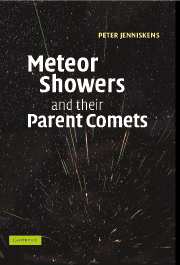Book contents
- Frontmatter
- Dedication
- Contents
- Preface
- Acknowledgements
- Part I Introduction
- Part II Parent bodies
- Part III Young streams from water vapor drag
- Part IV Young streams from comet fragmentation
- Part V Old streams and sporadic meteoroids
- Part VI Impact and relevance of meteor showers
- Appendix
- Tables
- Index
- Units and constants
Preface
Published online by Cambridge University Press: 05 July 2015
- Frontmatter
- Dedication
- Contents
- Preface
- Acknowledgements
- Part I Introduction
- Part II Parent bodies
- Part III Young streams from water vapor drag
- Part IV Young streams from comet fragmentation
- Part V Old streams and sporadic meteoroids
- Part VI Impact and relevance of meteor showers
- Appendix
- Tables
- Index
- Units and constants
Summary
It was a warm summer evening in June in the light polluted Dutch city of Leiden in 1981 when I first sat down and gazed at the sky, waiting. A meteor appeared and I made a wish: “One more, please!” After 90 min, I had plotted four arrows on a chart of stars. That record still exists and has played a small role in the ongoing exploration of meteor showers. A very modest beginning to what has become a lifelong adventure.
In those days, we were resigned to the believe that our two most intense showers had no parent body, that meteor showers were as irregular as the weather (and more difficult to predict), that meteor storms came unannounced, and that this would always be so.
Today, we have reached an impressive milestone: about half of all large (>1km sized) minor bodies approaching Earth's orbit have been discovered, two of which are the extinct comet nuclei that once produced the Geminid shower in December and the Quadrantid shower in January. The identification of the Quadrantid parent and several others were made in the course of writing this book.
Computers have revolutionized our insight into meteoroid stream dynamics. Meteor storm forecasting is now a reality. Over the years, amateur astronomers were witness to outbursts quite coincidentally. Now, storm chasing has become a popular pastime. In this book you will find much practical information about when to see meteor outbursts in the next 50 years and how they might manifest. We can look further into the future, but by 2050 the raw computing muscle of top-of-the-line computers is expected to have increased a million fold, at which time better predictions will surely be available than can be made now.
While writing this book, I found that many of our main meteor showers are the product of comet fragmentation. That new paradigm revives old ideas that had gone into submission after Fred Whipple proposed water vapor drag as the spring of meteoroid streams.
- Type
- Chapter
- Information
- Publisher: Cambridge University PressPrint publication year: 2006



